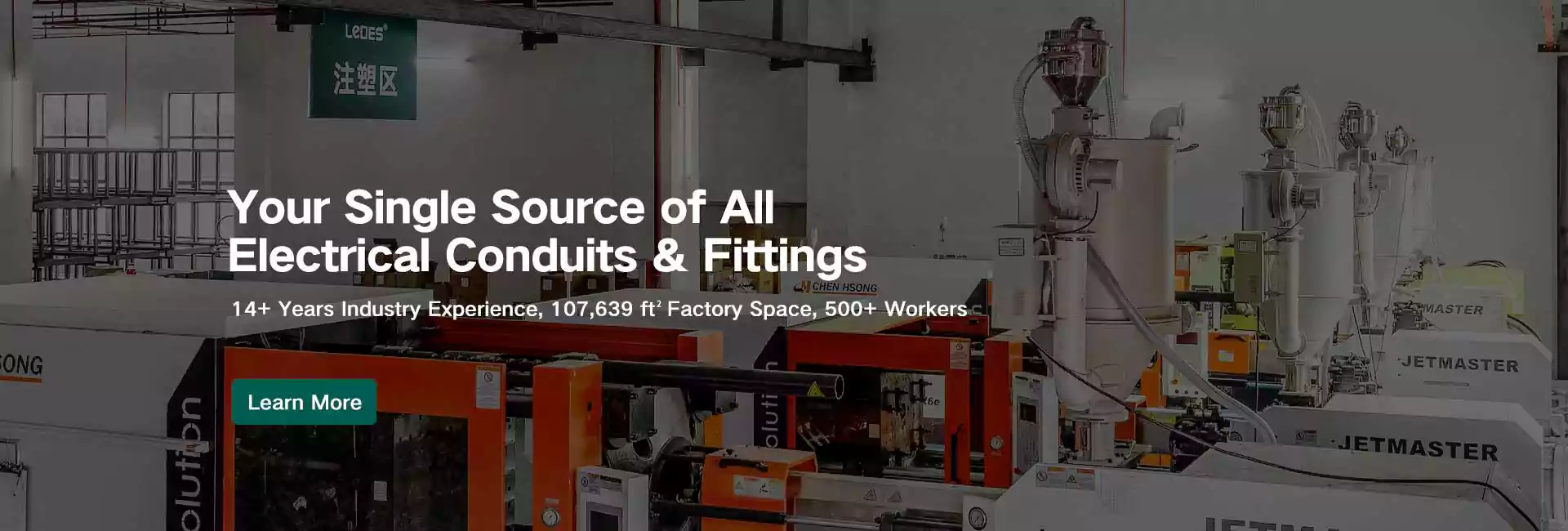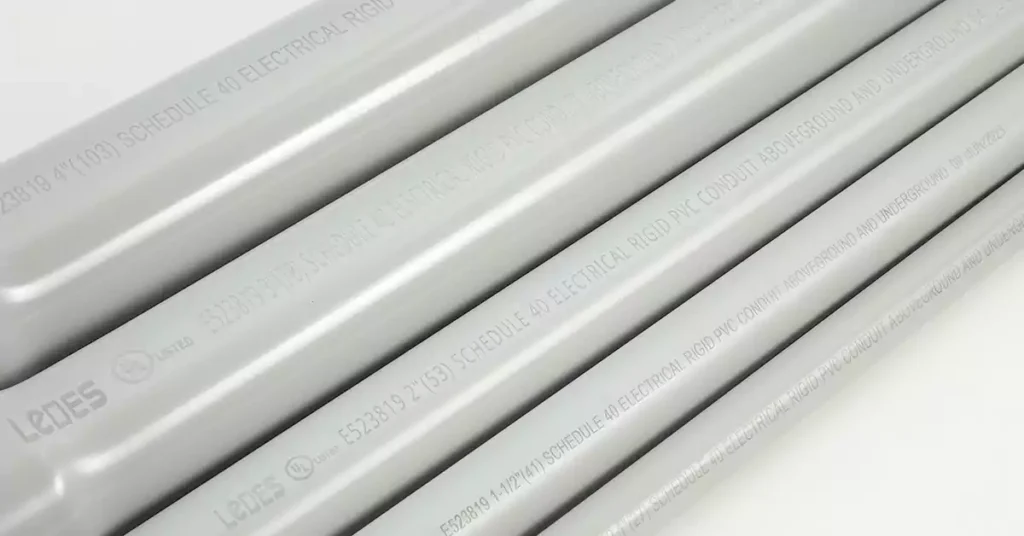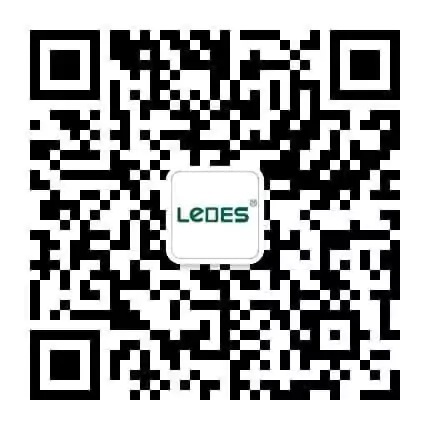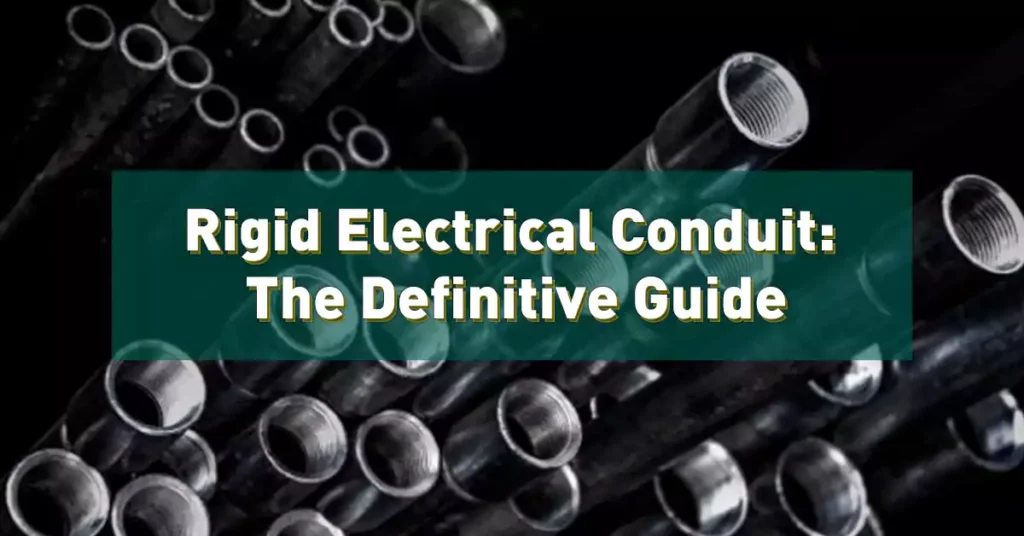
目录
刚性电气导管是电气系统中不可或缺的一部分,以其耐用性和防护性能而闻名,是各种应用的理想解决方案。本指南深入探讨了刚性电气导管,涵盖了其类型和特性、安装指南以及规范和标准的合规性。阅读完本指南,您将精通工业和住宅项目中刚性电气导管的选择、安装和维护所需的一切知识。
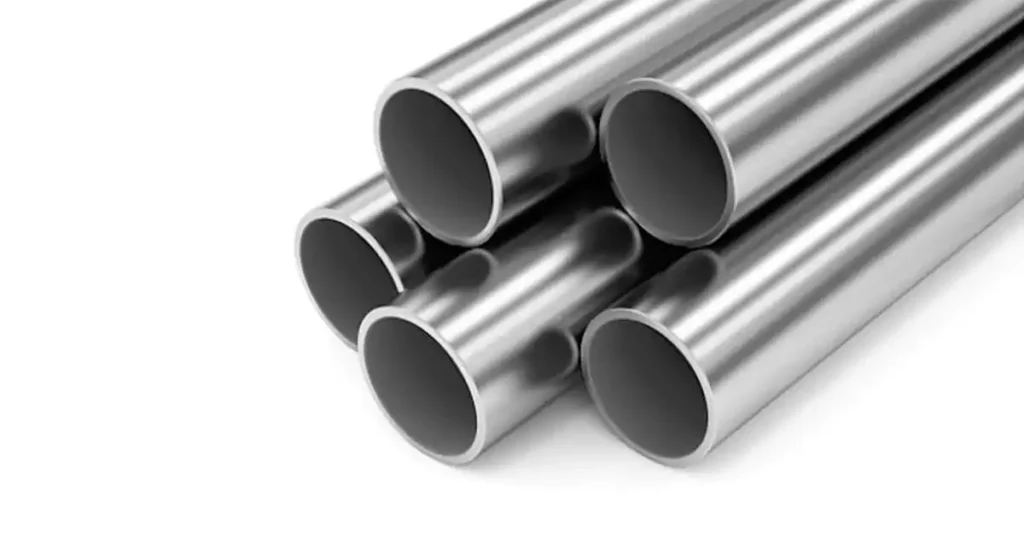
刚性电气导管 刚性导管是一种坚固的通道,可在各种环境中容纳和保护线路。与柔性导管不同,刚性导管坚固耐用,能够出色地抵御环境危害、物理损坏,甚至在某些情况下抵御电磁干扰。此类导管包含几种特定的导管类型,每种类型都有其独特的材料成分和适用于不同场景的适用性。
刚性导管具有多种优势,使其成为商业和住宅应用中的宝贵选择:
刚性电线导管可提供高水平的机械保护,防止物理损坏。它由钢、铝和 PVC 等坚固材料制成,可充当屏蔽层,防止意外撞击、挤压和磨损损坏内含的电线。这种耐用性确保即使在高流量或工业环境中也能保持布线安全。
刚性电线导管最显著的优势之一是其使用寿命长。镀锌钢或铝制成的导管可以使用数十年而不会出现明显的磨损。PVC导管虽然是非金属材质,但在各种环境条件下也拥有出色的耐用性。这种较长的使用寿命降低了维护成本和频繁更换的需求,使刚性导管成为一种经济高效的选择。
耐腐蚀性至关重要,尤其对于在户外或潮湿、腐蚀性环境中使用的导管而言。镀锌钢等硬质金属导管经过锌涂层处理,具有防锈防腐蚀性能。铝制硬质导管无需额外涂层即可提供天然的耐腐蚀性,是海洋和其他高湿度区域安装的理想选择。PVC导管是非金属材质,本身具有抗腐蚀性能,因此是地下或户外应用的理想选择,尤其适用于潮湿环境下的应用。
许多刚性导管,尤其是金属导管,都具有出色的耐火性。在存在火灾隐患的商业和工业环境中,这是一项至关重要的安全特性。金属导管可以控制电气火灾并防止其蔓延,为建筑物及其居住者提供额外的保护。这一特性符合各种优先考虑建筑材料耐火性的安全规范。
在使用电子设备的敏感环境中,EMI 可能会干扰信号并导致运行效率低下。金属导管(尤其是钢和铝导管)可作为 EMI 的天然屏障,确保敏感设备不受影响。这一特性使刚性金属导管成为数据中心、医院和工业设施等电子可靠性至关重要的场所的理想选择。
硬质导管,尤其是铝和PVC类型的导管,比很多人想象的更容易操作。虽然镀锌钢等硬质金属导管可能很重,但现代安装技术和工具简化了这一过程。铝质导管重量轻,易于切割和穿线,因此是劳动密集型项目的首选。PVC导管更轻,只需使用简单的工具即可轻松切割,并且可以使用PVC胶水快速连接。
刚性电线导管有多种类型,每种类型都针对特定的应用和环境。了解它们的特性、优势和局限性对于 为您的项目选择正确的类型下面,我们将探讨五种主要类型的刚性电线管,详细说明它们的优缺点,并包括行业标准规定的相关尺寸要求。
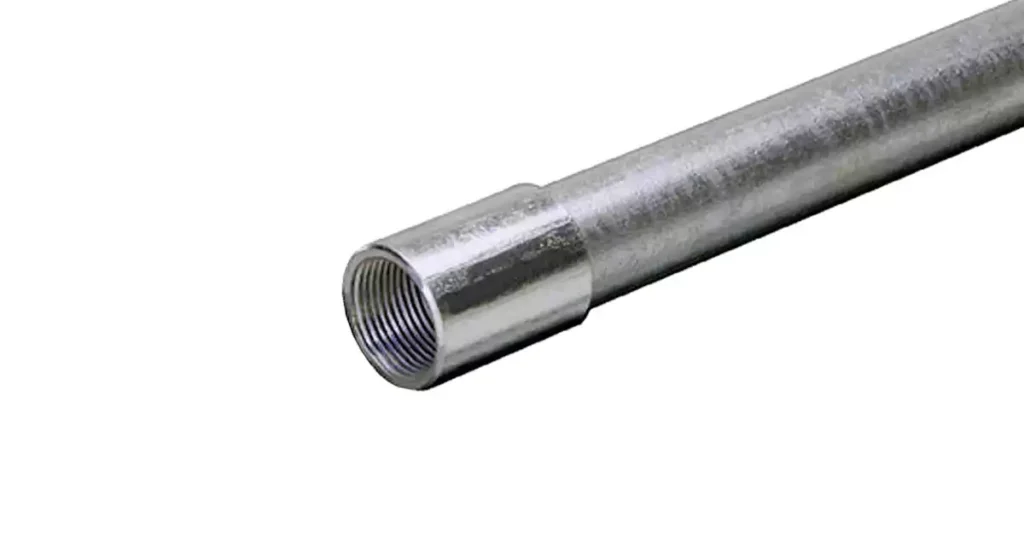
RMC 是最重、最厚的硬质电线导管,通常由镀锌钢制成。它专为需要最大程度保护的物理条件苛刻的环境而设计。该导管采用螺纹连接,并与接头和配件连接,为电线提供坚固的接地通道。
- 优点: 提供最高级别的机械保护;出色的耐火性;适用于需要可靠接地的区域。
- 缺点: 重量大,安装困难;比轻型替代品更昂贵;如果没有适当的镀锌或保护涂层,容易腐蚀。
尺寸要求:
最小尺寸: 不应使用小于公制标记 16(贸易尺寸 ½ 英寸)的 RMC。
最大尺寸: 根据 NEC 指南,不应使用大于公制标识符 155(贸易尺寸 6)的 RMC。
硬质铝导管在厚度和强度方面与RMC相似,但由于材质不同,重量明显更轻。它具有天然的耐腐蚀性,非常适合户外和船舶应用。
- 优点: 天然耐腐蚀,非常适合潮湿或沿海环境;重量更轻,简化了操作和安装。
- 缺点: 与钢导管相比,耐火性较差;可能需要专门的配件来与其他组件连接。
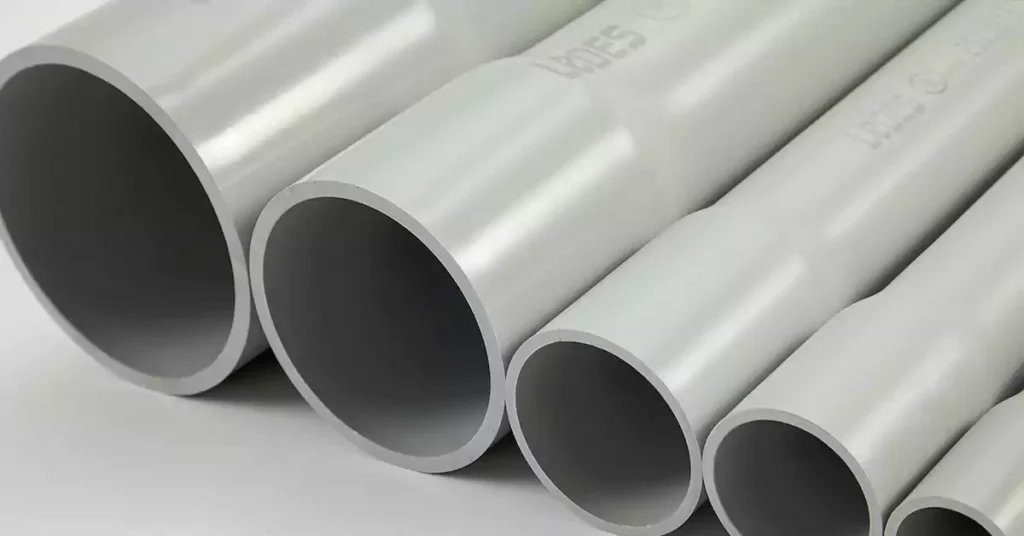
硬质PVC导管 是一种非金属替代品,以其轻质、耐腐蚀和耐化学腐蚀而闻名。它通常用于需要注意潮湿环境的地下或室外应用。PVC导管可以用溶剂型胶水粘合,以实现牢固、防水的连接。
- 优点: 不易生锈和腐蚀;重量轻,易于切割和组装;成本效益高,尤其适用于大型项目。
- 缺点: 对极端温度敏感,可能导致寒冷天气下变脆;耐火性有限;长时间暴露在紫外线下会使不稳定的 PVC 降解。
IMC是RMC的轻量化版本,提供类似水平的机械保护,但壁更薄。其设计旨在降低RMC的成本和重量,同时保持强度和耐用性。
- 优点: 很好地平衡了强度和重量;以比 RMC 更低的成本提供了显著的保护;适用于许多户外应用。
- 缺点: 接地效果可能不如 RMC 有效;安装时可能需要特殊工具。
玻璃纤维增强热固性树脂导管 (RTRC) 是一种非金属材质,以其高强度、高耐用性和耐腐蚀性而闻名。它常用于工业、户外以及可能暴露于化学物质或潮湿环境的恶劣环境中。玻璃纤维导管采用特殊粘合剂或机械配件连接,确保连接牢固耐用。
- 优点: 高度耐腐蚀和耐化学腐蚀;重量轻但坚固,简化了操作和安装;不导电,增加了安全优势;在极端温度下仍能保持性能。
- 缺点: 与 PVC 和金属导管相比,前期成本较高;需要小心处理以避免损坏;暴露在紫外线下会降解没有保护涂层的非稳定玻璃纤维;切割和安装可能需要特殊工具。
导管类型 | 材料 | 重量 | 应用 | 特殊功能 |
刚性金属导管 (RMC) | 镀锌钢 | 重的 | 工业、户外 | 防火接地路径 |
刚性铝导管 | 铝 | 轻的 | 海洋性、高湿度 | 耐腐蚀 |
硬质 PVC 导管 | PVC(聚氯乙烯) | 轻的 | 住宅,户外 | 非金属、抗紫外线 |
中间金属导管 (IMC) | 镀锌钢 | 中等的 | 商业、住宅 | 比 RMC 轻,强度高 |
玻璃纤维导管 (RTRC) | 玻璃纤维增强树脂 | 轻的 | 恶劣环境、化工厂、户外 | 高耐腐蚀性,可承受极端温度 |
每种类型的刚性电气导管都有其优势和特定的用途。选择哪种类型取决于环境条件、预算和安装要求等因素。选择正确的尺寸和类型可确保符合 NEC 和 NEMA 标准,从而有助于确保电气安装的安全性和效率。
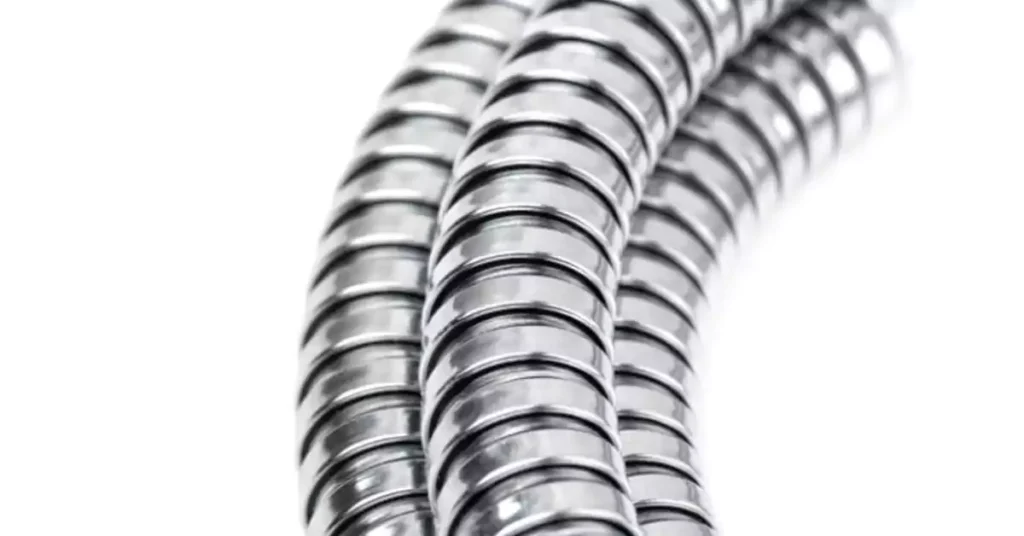
在选择电气金属管 (EMT) 和刚性金属导管 (RMC) 时,了解它们之间的差异对于根据项目需求选择合适的类型至关重要。虽然两者都是电线的保护通道,但它们的特性各不相同,这会影响它们在不同应用中的适用性。
EMT 导管 EMT 通常被称为“薄壁”导管,由镀锌钢或铝制成。它重量轻,壁比硬质导管更薄,因此易于操作、弯曲和安装。EMT 通常用于需要机械防护但防护强度不如工业环境的室内环境。
方面 | EMT导管 | 刚性金属导管 (RMC) |
壁厚 | 薄壁 | 厚壁 |
重量 | 重量轻,易于操作 | 重量较重,安装更具挑战性 |
耐用性 | 提供适度的机械保护 | 提供卓越的保护,防止物理冲击和环境危害 |
灵活性 | 高度灵活;易于用导管弯管机弯曲 | 柔韧性低;没有专门的设备很难弯曲 |
安装 | 更容易弯曲和切割;非常适合快速安装 | 需要螺纹和耦合,使安装更加费力 |
应用 | 通常用于室内受保护的环境,例如商业建筑和住宅环境 | 适用于可能暴露于恶劣条件的户外、地下或工业环境 |
成本 | 一般更实惠 | 由于材料厚度和耐用性而价格更高 |
防火性能 | 提供基本的防火性能 | 由于墙壁较厚,防火性能更高 |
接地 | 可作为设备接地导体 | 充当有效的接地路径并提供强大的电气连续性 |
EMT 和 RMC 均须符合 NEC(国家电气规范)的要求,以确保安全合规的安装。EMT 受 NEC 第 358 条管辖,而 RMC 则受 NEC 第 344 条管辖。该规范规定了每种导管的使用条件、支撑、接地以及允许使用的配件。
EMT 和 RMC 之间的决定取决于项目的独特要求:
选择 EMT 如果项目在室内,则需要具有成本效益,并且可以轻松进行修改。
选择 RMC 如果需要最大的耐用性、卓越的保护以及户外或工业级安装。
仔细考虑利弊,并遵守 NEC 指南,将确保所选的导管类型满足项目的安全和功能要求。
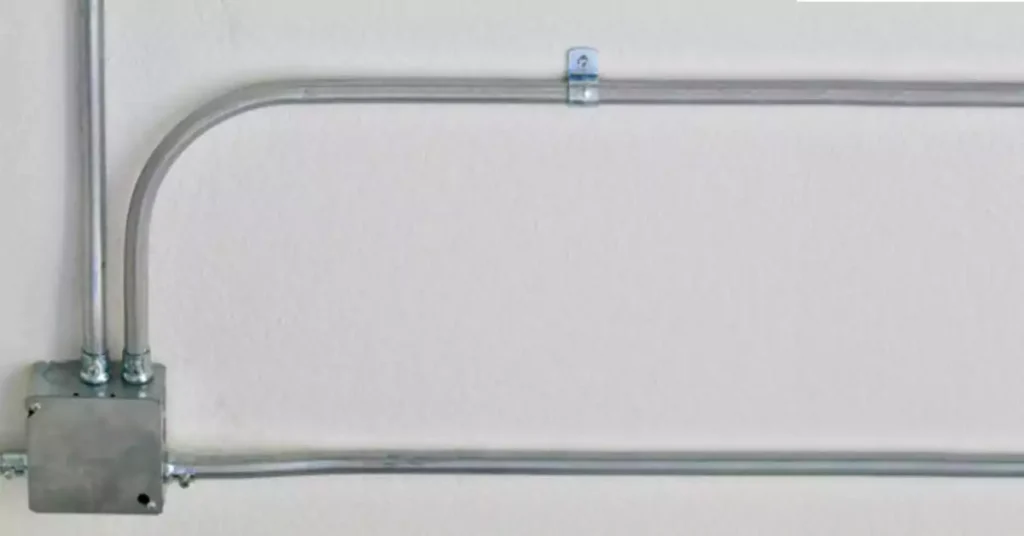
最常用的类型是金属导管(例如刚性金属导管,简称 RMC)和 PVC 导管。每种类型都有特定的应用、优点以及 NEC(国家电气规范)指南,以确定其适当的用途。
下面,我们根据 NEC 探讨金属和 PVC 硬质导管的允许用途,重点关注 第344.10条 用于金属导管和 第 352.10 条适用于 PVC 导管。
刚性金属导管 (RMC) 以其耐用性而闻名,适用于各种要求严苛的应用。根据 NEC 第 344.10 条,RMC 的允许用途包括:
- 一般用途:
RMC 可以安装在暴露和隐蔽的位置。
它适用于干燥和潮湿的环境以及容易受到物理损坏的地方。
只要安装了适当的保护涂层,NEC 就允许在所有大气条件和暴露条件下使用 RMC。
- 户外应用:
RMC 结构坚固,可提供针对天气和物理冲击的机械保护,非常适合户外安装。
常见的户外用途包括建筑物、停车场和户外照明系统的布线通道。
- 地下设施:
当安装适当的配件时,RMC 可以在地下位置使用。
这使得它成为防止潮湿和腐蚀的地下布线的热门选择。
- 危险场所:
由于 RMC 具有机械强度和耐火性,NEC 允许其在危险(分类)场所使用,例如涉及易燃气体或蒸汽的 I 类、1 区和 2 区区域。
- 腐蚀环境:
当 RMC 经过充分涂层处理或采用耐腐蚀材料(如不锈钢)制成时,它可以安装在具有中度至重度腐蚀影响的环境中。
PVC 导管 是一种非金属材料,以其耐潮和耐腐蚀而闻名。NEC 第 352.10 条概述了 PVC 导管的以下允许用途:
- 地上和地下设施:
PVC导管可用于地上和地下。地上安装时,必须按照NEC要求进行固定和支撑。
由于其天然的防潮和防腐蚀性能,它被广泛应用于地下设施,是保护地下电气系统的理想选择。
- 暴露和隐蔽位置:
PVC 导管可以安装在暴露的位置,但必要时必须防止其受到物理损坏。
它通常用于住宅、商业和工业建筑的墙壁、天花板和地板内的隐蔽空间。
- 腐蚀环境:
PVC 导管非常适合化学腐蚀性或易腐蚀的环境,例如化工厂或高湿度区域。
- 潮湿的地方:
由于 PVC 导管具有非导电和防水的特性,NEC 允许在潮湿的地方使用 PVC 导管。
它通常用于泳池区域、洗车场和类似的潮湿环境。
- 阳光直射:
如果 PVC 导管经过特殊标记或抗紫外线处理,则可以在阳光直射的地方使用。
- 温度考虑因素:
PVC 导管可承受温度波动,但应根据其额定温度进行选择。对于极端温度区域,请确保 PVC 导管类型符合 NEC 中规定的温度额定值。
遵守规范和标准对于确保电气装置的安全性、效率和使用寿命至关重要。国家电气规范 (NEC) 为不同类型的导管(包括硬质金属导管和 PVC 硬质导管)提供了明确的指导和要求。虽然我们在之前的文章中介绍过 PVC 导管,但本部分将深入解读 NEC 第 344 条,该条概述了硬质金属导管 (RMC) 的描述和要求。
刚性金属导管:NEC 第 344 条
PVC导管:NEC第352条
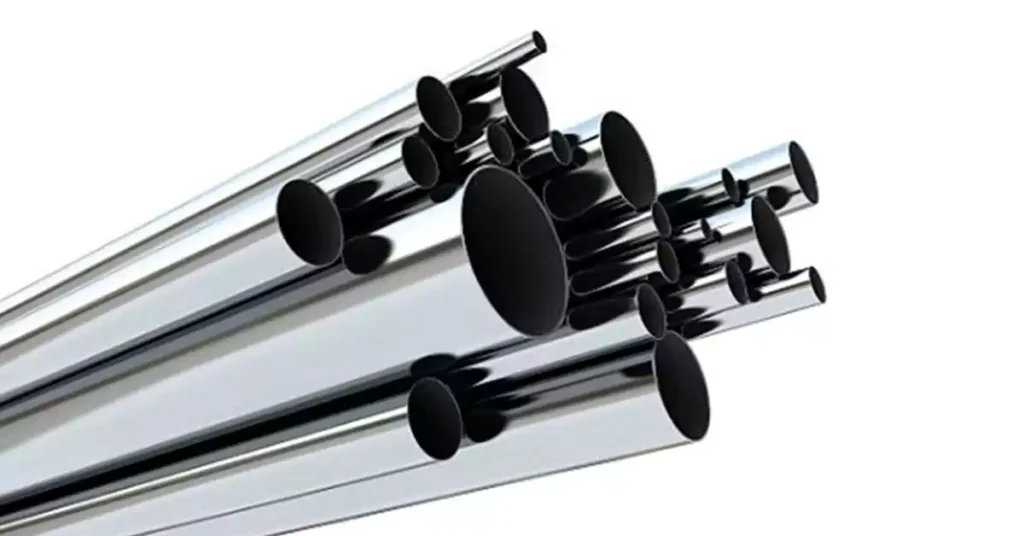
NEC 第 344 条规定了刚性金属导管的使用、安装和特性的全面指南。这些要求对于维护各种应用中的电气安全、结构完整性和规范合规性至关重要。该条款涵盖了允许用途、施工规范、接地和支撑要求等方面。
NEC 定义了 RMC 允许的贸易尺寸,范围从公制代号 16(贸易尺寸 1/2)到公制代号 155(贸易尺寸 6)。为确保最佳机械性能以及与标准配件的兼容性,不允许使用超出此范围的尺寸。
NEC 要求 RMC 内的导体数量必须符合第 9 章表 1 和相关表格中概述的填充容量限制,以防止过热并实现安全散热。
RMC导体数量(344.22)
导体或电缆数量 | 横截面积(%) |
1 | 53 |
2 | 31 |
超过 2 | 40 |
弯曲 RMC 时,必须保持导管内径不变形。NEC 规定了最小弯曲半径,以防止损坏并方便拉动电缆。这有助于保护线路免受过大的力,避免造成绝缘层损坏或导体拉伤。
RMC 的切割端必须进行扩孔以去除锋利边缘,确保电缆能够顺利穿过而不会造成损坏。此外,导管上的螺纹应清洁且形状正确,以确保连接牢固牢固,从而保持电气和机械的连续性。
RMC 必须在 3英尺(900毫米) 任何端接点(例如接线盒或配件)的间距不得超过 10 英尺(3 米)。此要求可防止下垂,从而可能危及安装的安全性和可靠性。
符合 NEC 代码 344.30 的固定和支持
导管尺寸 | 刚性金属导管支架之间的最大距离 | |
交易规模 | 米 | 英尺 |
1/2 – 3/4 | 3.0 | 10 |
1 | 3.7 | 12 |
1-1/4 – 1-1/2 | 4.3 | 14 |
2 – 2-1/2 | 4.9 | 16 |
3 及以上 | 6.1 | 20 |
正确安装后,RMC 可用作设备接地导体。这可确保故障电流的低阻抗路径,从而促进过流保护装置的运行,并提高整体系统安全性。
为了确保电气导管系统安全、可靠且符合规范,安装过程中需要使用各种配件和接头。这些组件对于连接、固定和过渡导管至关重要。本文将探讨硬质金属导管 (RMC) 和硬质 PVC 导管最常用的接头,并重点介绍它们之间的区别及其应用。
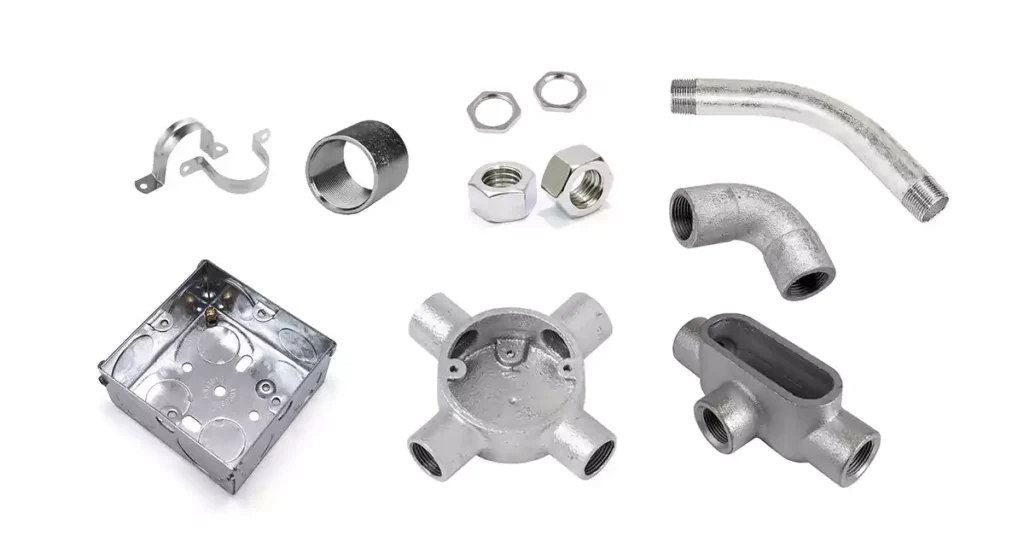
电气安装中,RMC 导管有 8 种常见配件,
- 联轴器: 连接两段 RMC 以创建连续路径。通常采用螺纹连接,以确保牢固连接。
- 连接器: 将 RMC 连接至电气箱或外壳,确保接地和稳定性。
- 肘部: 预成型的弯曲用于改变方向,保持拉线的平滑路径。
- 锁紧螺母和衬套: 锁紧螺母将导管固定到盒子上;衬套保护电线绝缘层。
- 带子和夹子: 支撑并将导管固定到表面,防止移动。
- 导管体: 提供拉线、接线或维护的通道。
- 接线盒: 用于连接多个导管、容纳接头和保护电气连接的金属盒。
- RMC 出线盒: 由金属制成,确保接地,耐用且能够承受高压环境;提供适合户外使用的防风雨型号。
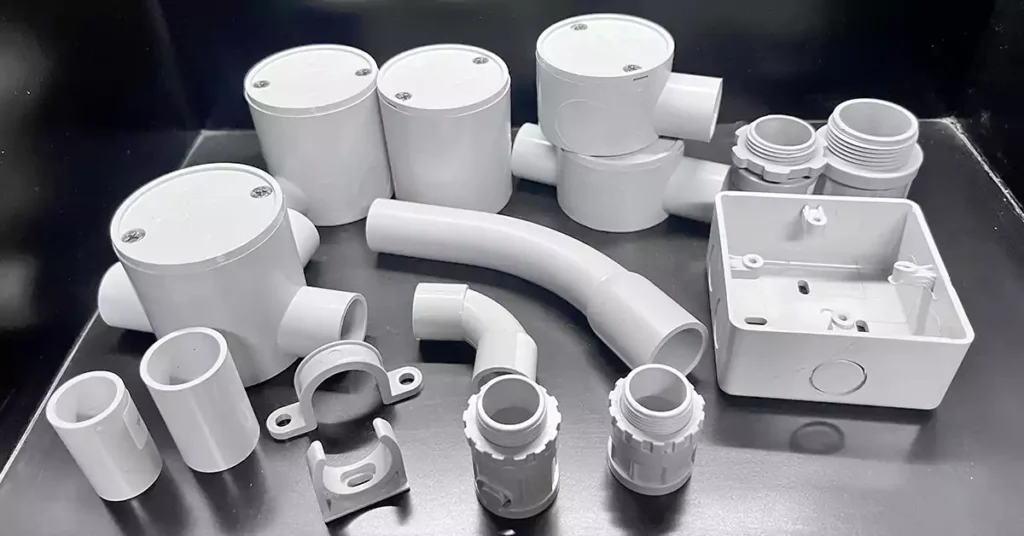
我们列出了 8 种常见的 PVC导管配件 这里,
- PVC接头: 用于将 PVC 导管各部分与溶剂胶连接起来,确保防水密封。
- 连接器: 将 PVC 导管连接到盒子,配有公头和母头适配器等类型。
- 膨胀联轴器: 允许因温度变化而膨胀和收缩。
- 肘部: 预制弯头用于改变方向,有 90° 和 45° 角。
- 带子和夹子: 用于将 PVC 导管固定到表面以确保稳定性。
- 导管体: 提供拉动或拼接电线的入口点,并有助于方向改变。
- 接线盒: 用于容纳连接和接头的 PVC 盒,由于其耐腐蚀性,通常用于室外或潮湿环境。
- PVC 插座盒: 不导电、耐腐蚀 PVC、重量轻、耐潮湿和耐化学腐蚀;提供适用于潮湿环境的密封盖型号。
材质成分: RMC 配件通常由金属(钢或铝)制成,以匹配导管的耐用性和接地性能。PVC 配件由聚氯乙烯制成,重量轻且耐腐蚀。
连接方法: RMC 配件通常使用螺纹或机械连接来连接各个部分,而 PVC 配件则使用溶剂胶连接以形成防水密封。
接地要求: 金属导管配件在接地电气系统中起着不可或缺的作用,而 PVC 导管系统可能需要单独的接地导体,因为 PVC 本身不导电。
灵活性: PVC配件具有更高的柔韧性,并且耐潮气和化学腐蚀,更适合潮湿或腐蚀性环境。另一方面,RMC配件则更坚固,适合需要增强机械保护的环境。
正确安装硬质金属导管 (RMC) 可确保电气系统安全耐用,符合规范要求,并有效实现预期用途。下文将提供 RMC 的分步安装指南。有关 PVC 导管安装的详细信息,请参阅我们的 PVC 导管安装综合指南。
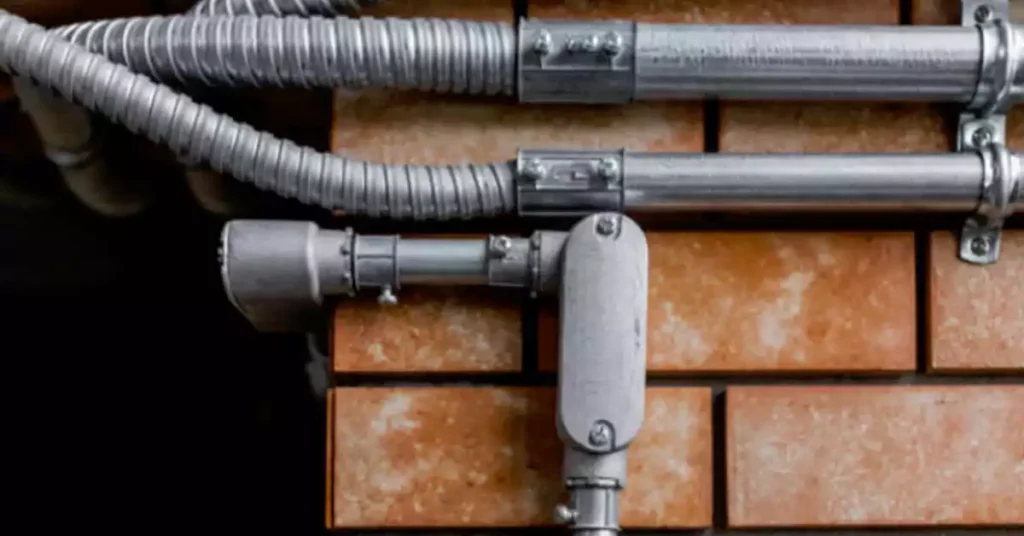
- 规划路线:
评估路径:确定最有效的路径,尽量减少弯道。
代码检查:确保计划路线符合 NEC 第 344 条和当地代码要求。
- 测量并切割导管:
测量:准确标记所需长度。
切割:使用管道切割机或钢锯,确保切割整齐、方正。
去毛刺:用铰刀或锉刀打磨任何粗糙的边缘,以保护电线。
- 线程:
创建螺纹:使用螺纹模将螺纹添加到导管的末端。
涂油:使用穿线油可以使过程更顺畅并防止损坏。
- 连接配件:
连接接头:将接头或连接器拧到导管的末端。
牢固拧紧:使用扳手拧紧,注意不要拧得太紧。
- 根据需要弯曲:
使用弯管机:要改变方向,请使用手动或液压弯管机。
避免急弯:确保弯头符合 NEC 半径标准。
- 安装导管:
用带子固定:使用金属带按照所需的间隔将导管固定到表面上(通常在箱子 3 英尺以内,直线部分间隔 10 英尺)。
间距:遵循 NEC 间距要求。
- 拉电线:
插入鱼带:将鱼带穿过导管并连接电线。
涂抹润滑剂:长距离运行时使用拉线润滑剂。
小心拉动:轻轻拉动电线以避免扭结。
- 最终检查:
拧紧并固定:确保所有配件均牢固连接。
检查接地:按照 NEC 第 250 条验证接地是否正确。
测试连续性:执行测试以确认连续的接地路径。
- 防风雨(适用于室外安装):
密封入口:使用密封剂防止湿气进入。
安装套管:保护导管入口处的电线绝缘层。
防护装备: 佩戴安全眼镜、手套和靴子。
避开电线: 确保该区域没有带电电线。
使用适当的工具: 始终使用专为 RMC 工作设计的工具。
以下是十个 美国和加拿大领先的刚性电气导管制造商,重点介绍他们的公司背景、产品供应和市场地位。
公司概况: ABB是电气化和自动化领域的全球领导者,在北美拥有强大的影响力。ABB以注重创新和可持续发展而闻名,提供旨在优化各行各业能源效率的解决方案。
产品: ABB 的导管解决方案包括刚性金属导管 (RMC) 和电气金属管 (EMT),专注于耐用、高性能的材料。
市场地位: ABB 以其创新技术和可靠的产品而闻名,服务于包括工业和商业应用在内的各个领域。
公司概况: Atkore is a leading manufacturer of electrical conduit and cable management solutions. Their wide range of products is designed to meet the needs of various industries, from industrial to residential construction.
产品: Their product line includes rigid metal conduit (RMC), electrical metallic tubing (EMT), and PVC conduit, with a focus on versatility and compliance with stringent standards.
Market Leadership: Known for robust distribution networks, Atkore ensures timely product availability throughout North America.
Company: Specializing in corrosion-resistant conduit systems, Robroy Industries has built a reputation for delivering durable solutions for harsh environments, particularly in the oil, gas, and chemical industries.
产品: They produce rigid steel and PVC-coated rigid metal conduits, which are ideal for harsh environments.
Industry Experience: With over 100 years of experience, Robroy focuses on providing conduit solutions that are built to last, offering customers peace of mind for projects in extreme weather or corrosive environments.
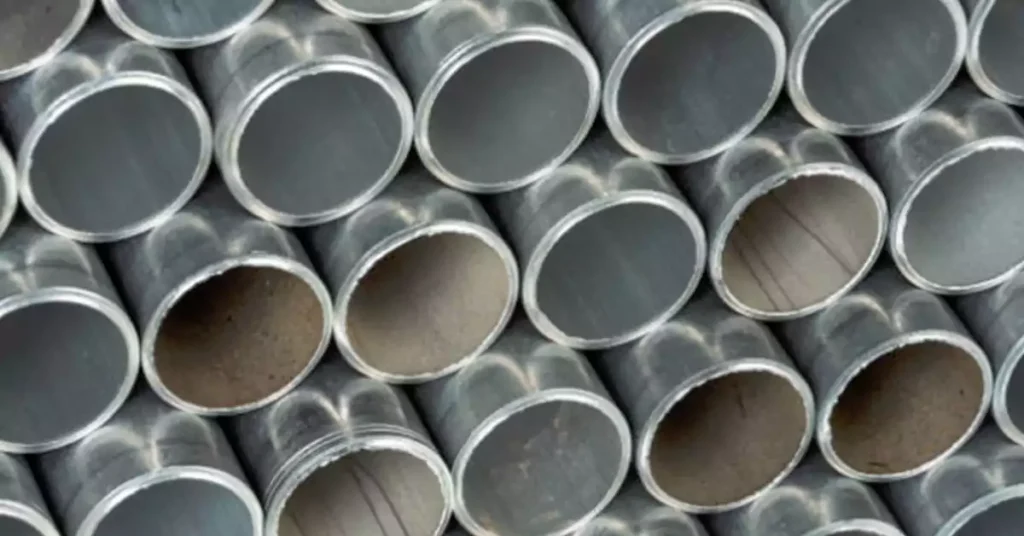
公司概况: Part of Zekelman Industries, Western Tube manufactures high-quality steel conduit products with a strong focus on domestic production and fast delivery.
产品: They offer a broad range of rigid metal conduit (RMC) and electrical metallic tubing (EMT), designed to meet the electrical needs of residential, commercial, and industrial applications.
市场认可: Western Tube has an established presence in the North American market, with a reputation for producing high-performance products that comply with national standards, while maintaining cost-effective pricing.
公司概况: Ipex is a global leader in thermoplastic piping and conduit systems. Based in Canada, Ipex has an extensive product portfolio and has been a key player in the North American market for over 50 years.
产品: They specialize in rigid PVC conduit, which is lightweight, corrosion-resistant, and cost-effective, with applications ranging from residential to large commercial projects.
Environmental Sustainability: Ipex is committed to environmental sustainability, using eco-friendly manufacturing processes and materials to create products that meet stringent regulatory requirements and environmental standards.
公司概况: JM Eagle is one of the largest plastic pipe and conduit manufacturers in the world. They have a long history of producing high-quality, durable products at scale.
产品: Known for their rigid PVC conduit, JM Eagle’s products are highly regarded for their strength, affordability, and ease of installation.
Sustainability: JM Eagle has a robust commitment to sustainability, offering products made from recycled materials and focusing on reducing environmental impact through energy-efficient manufacturing processes.
公司概况: RITTAL is known primarily for its enclosures, IT infrastructure solutions, and automation systems. Their electrical conduit offerings complement their broader industrial solutions.
产品: RITTAL’s rigid electrical conduit products are designed to integrate with their wide array of automation and industrial enclosure solutions, providing comprehensive protection for electrical systems in high-tech environments.
Company Focus: RITTAL is highly focused on providing tailored solutions for complex industries such as IT, telecommunications, and manufacturing, where precision and reliability are paramount.
公司概况: As a division of Zekelman Industries, Wheatland Tube has over 80 years of experience in the manufacturing of steel conduit. They are one of the largest producers of electrical conduit products in North America.
产品: Wheatland Tube produces a wide range of rigid metal conduit (RMC) and EMT, providing excellent protection for electrical wiring in a variety of environments.
High Quality: Wheatland Tube is known for their commitment to quality and customer service, offering products that meet or exceed NEC standards and ensuring timely deliveries for large-scale projects.
公司概况: A major player in the steel industry, NUCOR produces high-quality conduit solutions as part of its vast portfolio. Known for its sustainability efforts, NUCOR is a leader in energy-efficient steel production.
产品: NUCOR’s rigid metal conduit (RMC) is known for its durability and strength, making it ideal for large infrastructure projects in industrial and commercial applications.
Sustainability: NUCOR’s conduit products reflect their commitment to sustainability, offering customers eco-friendly, long-lasting solutions that meet the highest quality standards.
公司概况: Ledes conduit specializes in high-performance electrical conduit systems designed for residential, commercial and industrial applications.
产品: Ledes offers PVC conduit, low-smoke, halogen-free rigid conduit, primarily used in environments where safety and fire resistance are critical, such as healthcare facilities and public buildings.
Commitment to Quality: With a focus on safety and compliance with the industry regulations, Ledes is a trusted supplier for projects requiring enhanced environmental and safety standards.
Choosing the right rigid electrical conduit is essential for the safety, durability, and efficiency of your electrical system. Here are some simple guidelines to help you select the best conduit for your project:
Outdoor Exposure: If the conduit will be exposed to weather, go for materials that resist corrosion, such as rigid metal conduit (RMC) or aluminum rigid conduit (ALR). PVC conduit is also a good option for areas that won’t face extreme weather.
腐蚀: For areas with high moisture or chemicals (like coastal areas or factories), PVC-coated RMC or PVC conduit offers extra protection against rust.
Residential vs. Industrial: For residential or commercial use, PVC conduit or EMT conduit are affordable and easy to install. For industrial sites that need extra protection, RMC is more suitable.
Fire Safety: If fire safety is a priority (for example, in hospitals or schools), look for low-smoke, halogen-free rigid conduit or fire-resistant PVC conduits.
Make sure the conduit is large enough to fit the wiring and allows for proper airflow. Don’t over-stuff the conduit, as this can lead to overheating and damage. Also, be aware of size limits: RMC should not be smaller than 1/2 inch or larger than 6 inches, as specified by NEC Article 344.
配件: The type of conduit you choose must match the fittings, connectors, and boxes used. For example, RMC needs specific types of connectors, while PVC conduit has its own set of fittings and may be easier to handle and install.
Existing Systems: If you are expanding or updating an electrical system, choose conduit that matches your existing setup to avoid extra modifications.
NEC Compliance: Your conduit needs to meet the National Electrical Code (NEC). RMC is covered by Article 344, and PVC conduit by Article 352. Make sure you review these codes to ensure your project is compliant.
Local Codes: Check if there are any local building codes or extra requirements specific to your area or project.
安装简便: PVC conduit is lighter and easier to install compared to RMC, which may need special tools and more labor. Consider your project timeline when choosing.
成本: PVC conduit is generally cheaper than RMC but may not offer the same level of protection. Think about balancing upfront cost with long-term durability.
Expansion: If you expect to expand or modify your system in the future, consider the flexibility of the conduit. EMT is more flexible, while RMC offers more protection but is harder to modify.
Maintenance: PVC conduit is low-maintenance, while metal conduits may need periodic checks for rust or damage.
Selecting the right rigid electrical conduit depends on your project’s needs, environmental conditions, budget, and compliance with building codes. Consider the factors above, and if in doubt, consult an electrician to ensure your system is safe and up to code.
For additional resources, consult:
NEC Code: Official NEC publications offer guidelines on conduit use.
NEMA Standards: NEMA’s website provides access to ratings and requirements for conduit materials.
Manufacturer Data Sheets: Specific installation guidelines are often provided in product datasheets.
Consult an Electrician: An experienced electrician can offer insights on local code requirements and best practices.
Choosing the right rigid electrical conduit is a crucial step in ensuring the safety, durability, and efficiency of your electrical system. From understanding the different types of rigid conduits, such as RMC, PVC conduit, and EMT, to considering factors like environmental exposure, fire safety, and code compliance, each decision plays a key role in the overall performance of your installation. By evaluating the specific needs of your project and selecting the appropriate conduit, fittings, and accessories, you can create a reliable and long-lasting electrical system.
As we’ve seen throughout this guide, it’s important to understand the benefits, applications, and installation requirements of each conduit type, as well as how they align with the standards set forth by the NEC and other codes. Whether you’re working on a residential, commercial, or industrial project, the right conduit ensures your electrical system stays protected and efficient for years to come.
Always keep in mind factors like installation ease, cost, future maintenance, and expansion when making your choice. And, of course, consult with professionals to ensure your system meets all safety and regulatory standards. With this knowledge in hand, you’re now ready to make an informed decision and confidently choose the best rigid electrical conduit for your next project.
We always highly appreciate if you can touch with us if you still have any questions; our electrical conduit expert will reply to you in 1 business day.

